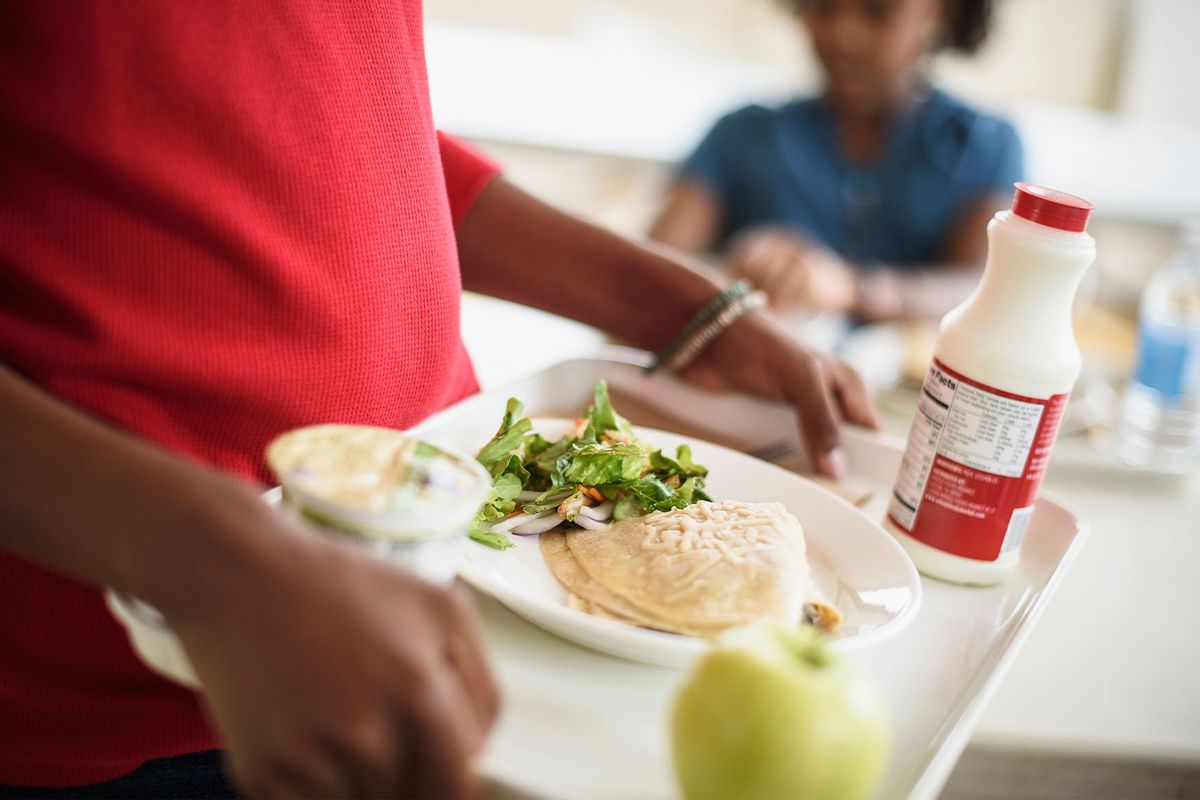Many nutrition and public health professionals started this current school year in a state of mourning. The object of their grief: universal school meals, a national initiative made possible by the pandemic. Waivers were granted to allow schools to provide free breakfasts, lunches and snacks to all children without asking for proof of need or requiring those meals to be eaten in congregate settings — meaning, kids could take home grab-and-go foods during COVID lockdowns. As a result, childhood food insecurity decreased from 2020 to 2021, according to USDA data; the waivers were allowed to expire this fall due to objections from Republican senators.
More than merely keeping kids fed, school meals "are the healthiest meals that kids are eating, because they are modeled after dietary guidelines where half of the plate is fruits and vegetables and they're . . . offering a lot of whole grains and lean proteins," says Diane Pratt-Heavner, a spokesperson for the School Nutrition Association (SNA), which represents 50,000 public school nutrition professionals. "If we could get everyone eating school meals, we would see an improvement, not only in academic achievement of our students, but in their long-term health and wellness."
While advocates continue to push for permanent, national universal school meals, Colorado passed a ballot initiative in the midterms, joining California and Maine in making universal school meals available to all in-state children; similar proposals are being considered in eight other states. A recent analysis by reporter Helena Bottemiller Evich and online monitoring company Impact Social found that public sentiment for universal school meals was "overwhelmingly positive," she wrote.
But with or without universal school meals, pretty much anywhere you look across the country efforts are afoot to further improve the nutritional value of school meals and to make them available to a lot more children. The catch: there are big challenges that, ironically, would be mitigated if universal school meals for all had been allowed to continue.
Prioritizing scratch cooking
Scratch cooked meals rather than heat-and-serve options sourced from distributors are not only preferred by kids; they're also healthier by a number of metrics (they're generally lower in sodium, sugar, and fat and better at getting students to eat fresh fruits and veg, for example). But there are schools that aren't able to provide scratch cooked meals because they lack full-service kitchens or the kitchens they do have are "operating with incredibly old equipment, insufficient equipment, or held together by duct tape," says Pratt-Heavner.
In some cases, says Hilary Seligman, a food insecurity expert and professor at University of California, San Francisco, kitchens were actually removed from schools starting in the '80s "in the interest of cost efficiency," to stretch the limited money that USDA reimburses to schools for meals. Currently, the reimbursement is almost $4.50 per lunch for free-lunch students, 40 cents of which was authorized by the Keep Kids Fed Act that amended the earlier Families First Corona Virus Response Act to extend waivers and provide extra funding to budget-strapped nutrition departments. It will disappear at the end of the 2022-23 school year. Advocates say even the current top rate is not sufficient for some schools to purchase enough healthy foods for menus; the last raise came in 2010, under the Healthy Hunger-Free Kids Act, which upped lunch reimbursements by 6 cents.
"We need to see more progress in how we think about rewriting the reimbursement rate and increasing access to what we think about as eligible foods for reimbursement," says Robert S. Harvey, president of healthy school food nonprofit FoodCorps. "On one hand there's the cash component, on the other hand, there's the context component: nourishing, culturally affirming foods like buffalo if you're in indigenous and native territories, wild rice, fresh salmon, that aren't considered eligible for reimbursement" because of outdated (and Eurocentric) USDA guidelines .
This past July, Congress authorized USDA to give out $30 million in equipment grants to schools, which was then upped in October by an additional $50 million. Experts agree that $80 million to build, rebuild and refurbish school kitchens is important. But Seligman calls it "a drop in the bucket of what our schools probably need," and a number of interrelated challenges stand in the way of that money going as far as it needs to, or anytime soon. For starters, says Pratt-Heavner, continuing supply chain issues are making it difficult for repair technicians to get their hands on necessary parts.
There's also a labor shortage. "We hear time and time again that school nutrition programs are competing for many of the same workers as local fast-food restaurants," Pratt-Heavner says. "It can be very difficult for school nutrition programs to compete."
Universal school meals would help. That's because each school's nutrition program is expected to be self-sufficient, enrolling enough students in the meal plan so that reimbursements from USDA (as well as payments from full-price students) help cover things like salaries. But when kids opt out, perhaps because their families can't afford to pay for meals or the paperwork is too onerous and confusing, enrollments and reimbursements suffer and so, too, do nutrition program revenues.
Increasing farm to school and local sourcing
Pratt-Heavner says there's been a tremendous improvement in local sourcing over the last decade, thanks in no small part to USDA's Farm to School program, funded by the Healthy, Hunger-free Kids Act during the Obama administration; this assists schools in procuring food from nearby farms, and establishing school gardens and other food-related education programs. Local sourcing actually got a boost during the pandemic. "One silver lining of all those supply chain issues is that some districts were able to establish new connections with local growers, when their traditional vendors and distributors were unable to meet the need," Pratt-Heavner says.
Miguel Villareal, interim co-executive director of the National Farm to School Network, a nonprofit that serves as an information, advocacy, and networking hub, says that in 2018-'19, 72% of school food authorities reported participating in Farm to School programs. "That's an average of over 43 million children that are being impacted," he says — a huge uptick from when he began as a school nutrition director 20 years ago in Marin County when "we were serving highly processed foods even though we were surrounded by over 60 organic farms." He notes another data point of significance: $1.26 billion dollars per year is currently being spent on Farm to School programs.
Here, too, there are hiccups to expansion. Pratt-Heavner points out that "really big school districts struggle to find local growers who can actually meet their demand and meet it consistently; your local farmer may only be able to provide enough asparagus for a quarter of the students you serve and you don't want to be in the habit of only offering this fresh local produce to a select few elementary schools."
Harvey says some help is on the way, via USDA's Local Food for Schools Cooperative Agreement Program, which will provide states with $200 million for local food procurement. But again, universal meals could mitigate this issue. It would be a massive step to "remove the bureaucratic red tape of charging kids for meals and the amount of time that school nutrition directors and leaders spend on the application families have to fill out to determine their capacity for meals," Harvey says.
"Nourishing futures"
Part of the broader farm to school movement, FoodCorps has a mission to equitably expand access to healthy meals and education for all schoolkids, with an emphasis on foods that are culturally relevant. At the recent White House Conference on Hunger, Nutrition, and Health, FoodCorps — an AmeriCorps program that's partially funded by federal dollars — announced it would be stepping up its efforts heading towards 2030 with a $250 million investment into what it calls its Nourishing Futures initiative.
"We are committed to the idea of food education being critical to unlock to students' experiencing nourishing meals in school and part of that narrative is that nourishment is not just about caloric intake or nutritious value; it's also about ensuring that every meal that a child experiences on their plate affirms their sense of identity," Harvey says. "How do we ensure that young people, regardless of race or place, experience a nourishing meal that deepens that sense of food equity?"
Over the next eight years, Nourishing Futures will be working to bring healthy school meals to another 500,000 school kids on top of the over 130,000 they already serve; educating 1,000 BIPOC food education service members to work in those understaffed school nutrition offices, "to inform menu creation and vendor selection, deepen the relationship with local farmers, and help to think about scratch cooking and kitchen modernization," according to Harvey. He says there will be an emphasis less on "caloric intake and more about fresh fruits and vegetables, fresh meats, locally sourced, scratch-cooked in a kitchen [and] not processed, not packaged, not shipped in and held in the heat container for the school day."
Unsurprisingly, the initiative will also push for a federal policy on universal school meals.


Shares